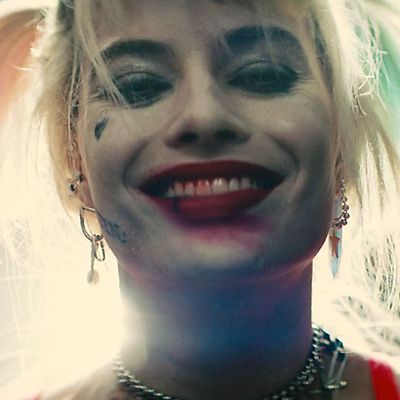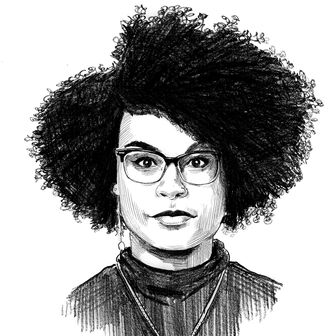
Early in Birds of Prey, there’s a fantastical scene that places its star in a curious lineage. Margot Robbie’s vivacious Harley Quinn is tied up and being threatened by mob boss Roman Sionis, a.k.a. Black Mask. After a brutal slap across the face, her mind wanders to an arch reimagining of the “Diamonds Are a Girl’s Best Friend” sequence from the 1953 film Gentlemen Prefer Blondes. Dressed in a magenta jumpsuit, dripping in diamonds, against an achingly pink backdrop, Harley becomes an emblem of blissful chaos. In the number, she bites the outstretched hand of one of the suited men around her. She knocks two of their heads together. She jauntily dances with Black Mask, her face shifting from a mocking pout to a face fiery with mischief. She disrupts the lacquered surface of the often-parodied musical number with a spiky quality. And she never gets lost in the sequence’s rapid-fire editing or the hail of bullets that surround her.
Watching the number, I couldn’t help but think of the continuum of Hollywood blondes on which Robbie exists. From Peg Entwistle, an actress remembered most profoundly by her death, to Marilyn Monroe’s complicated legacy, to more modern examples like Jennifer Lawrence, the blonde in Hollywood history sheds light on beauty politics, the nature of stardom, and racialized hierarchies. To be a blonde bombshell may earn attention, but beauty so often is a double-edged sword in the industry. And the kind of lacquered surface required of a bombshell allows a narrow range of onscreen existence. This is something Robbie herself is clearly aware of. When the actress was told by a Vogue writer that it’s nearly impossible to find a story about her without the word “bombshell” in it, she responds, “I hate that word. I hate it — so much.”
The blonde bombshell distinction may put an actress on the scene, but it’s an image that lacks the elasticity and curiosity Robbie has demonstrated over the course of her brief career, playing characters as different as the hard-edged, infamous ’90s figure skater Tonya Harding in I, Tonya, the fractured Queen Elizabeth I in Mary Queen of Scots, and the effervescent Sharon Tate in Once Upon a Time in Hollywood. As Anne Helen Petersen notes about Robbie in her in-depth exploration of her nascent career as an actor and producer, “Producing was also a way for Robbie to excuse herself from the imperatives of patriarchal Hollywood — whose standards might have helped elevate her in the first place, but had quickly become claustrophobic.” Robbie has shirked the bombshell image by embracing the opposite: the unruly woman, a type exemplified by Harley Quinn, who has become one of the most popular characters in the DC Comics stable for her joyful chaos and meta commentary. In Birds of Prey, Robbie’s performance as Harley is a textured, uproarious celebration of female excess, wholly guided by tactile pleasures. Director Cathy Yan and writer Christina Hodson blessedly keep the film from falling into simplistic girl-power platitudes. But they are aware of the larger forces that deny women the ability to be angry and bold, threading larger considerations about gender and the politicized nature of desire into the film without ever losing sight of its aesthetic pleasures.
Here’s the thing about being an unruly woman. It doesn’t take much to gain that distinction. Talk too much, too loudly, and that’s enough. As Rachel Vorona Cote writes in her book, Too Much: How Victorian Constraints Still Bind Women Today, “A weeping woman is a monster. So too is a fat woman, a horny woman, a woman shrieking with laughter. Women who are one or more of these things have heard, or perhaps simply intuited, that we are repugnantly excessive, that we have taken illicit liberties to feel or fuck or eat with abandon … A woman who meets the world with intensity is a woman who endures lashes of shame and disapproval, from within as well as without.” What makes Harley Quinn so thrilling is that she provides another option — one where the unruly woman is allowed to cut loose and triumph over the emblems of misogyny in her life.
Harley most immediately takes up space with her voice. We’re introduced to her through an animated opening, in which she narrates her journey from a scrappy childhood to losing herself in the folds of the Joker’s overwhelming charisma. Harley’s voice is one of the most distinct qualities of the character — Brooklyn-adjacent, high-pitched, always leaning into the humor of the moment. It was first defined by Arleen Sorkin, in the early 1990s cartoon Batman: The Animated Adventures. Later, it was memorably taken up by Tara Strong in the Batman: Arkham games, who made it more rough-hewn. At times, Robbie’s natural accent warbles through, but what she lacks in precision she makes up for in unrelenting energy and wry humor. Her Harley has a more rounded, bawdier voice. Less baby-voiced, more grown, it acts as a weapon. She rattles off psychiatric insights, poking fun at Black Mask’s delicate sense of self. She spits jokes as cleverly and often as curses. Her laugh is a demented giggle that often pierces through the chaotic action of explicit scenes. Robbie’s voice works in tandem with the character’s relationship with the camera — sly, conspiratorial when breaking the fourth wall, her glare nearly piercing through the screen. But it’s just one aspect of Harley’s unruliness.
Birds of Prey is a film guided by the pleasure principle: the plentiful use of the word fuck, a smattering of colors like glittery teal and cotton-candy pink, and often, a healthy appreciation of food. One of the best sequences involves Harley simply trying to eat a beloved egg sandwich from a local shop. As her hair gently rustles from some unseen fan, her gaze melts into one of unquenched desire, lips parting in anticipation. Before she can take her first bite of the sunny-side-up egg, perfectly buttered toast, and American cheese with just a dash of hot sauce, Detective Renee Montoya (Rosie Perez) decides to chase Harley through the crowded outdoor shops of Gotham. Harley is momentarily distracted by a rainbow-sequined fanny pack, her face melting into awe, until she sees how close Renee is to catching her. Just when she thinks she’s safe — reassuring her egg sandwich, “It’s okay, we’ll get through this” — Renee tackles her, sending her meal flying in the air, landing onto the asphalt in a sloppy heap. Robbie mines this moment for humor, leaning into the character’s natural sense of exaggeration. She crooks her jaw dramatically to the left and cries out, “No!” Her body slams against the asphalt, reaching toward the lost sandwich, looking directly at the camera as her eyes brim with tears. On its face, this moment is hilarious. But it also speaks to Harley’s dedication to the pleasures in life, above all else. The superhero genre is often wildly disconnected from the simple joys of being human. So to witness a female character like Harley eating with abandon and treasuring her desires rather than dampening them feels electrifying. Her unruliness is a potent antithesis to the glossy, never a hair out of place, shallow renditions of female characters in comic-book films.
Much of the scintillating excess of Birds of Prey is thanks to the costuming by Erin Benach. Harley dons a clear jacket with sleeves made of caution tape and confetti, gold leather overalls with a hot-pink crop top underneath, a floor-length coat dripping in silver sequins. Robbie transforms in these costumes, matching their vibrancy and boldness with a sharp-edged physicality that shows little regard for the world around her, constantly wreaking havoc wherever she goes. And the costuming is more than just aesthetically dazzling — it wrests the character from the male gaze that defined her in 2016’s Suicide Squad. In that film, she wore skimpy, sequined hot pants with a thin shirt displaying her torso. The clothing in Birds of Prey doesn’t shy away from showing skin, but rather than objectify, it reflects Harley’s audaciousness. For this reason, it isn’t surprising that a small but vocal contingent of men on Twitter grumbled about the lack of sex appeal in the movie.
Comic-book films and other would-be blockbusters are becoming more diverse by degrees, offering a wider array of female characters. But with this has come a frustratingly hollow, corporate-minded feminism that deems a moment like the “Just a Girl” needle drop in Captain Marvel as progress rather than the cynical ploy it actually is. Yan and Hodson bypass this by interweaving moments and gestures that call attention to the prosaic, misogynistic encounters women face in a way that provides a trenchant framework for Harley’s unruliness.
In a pivotal scene midway through the film, Harley is severely drunk outside of Black Mask’s club with a man who coos in her ear and ignores her pleas to go home. Her body is supine in his grasp, barely able to stand up on her own. He drags her to a van, intending to assault her. But before he can, the singer and future superhero Black Canary (Jurnee Smollett-Bell) saves Harley, effortlessly kicking and subduing the men who planned to harm her. What’s crucial about this scene is that Black Canary and Harley aren’t allies yet. (Actually, far from it — Black Canary finds Harley absolutely annoying.) The moment speaks to the camaraderie among women who must protect each other against the larger forces that shape their lives. The film takes a sidelong glance at the idea that the very quality that makes Harley so electrifying to watch also makes her an annoyance and target in a patriarchal society that wants to destroy that spirit.
The world doesn’t quite know what to do with women’s passions. It’s easy for the vigorous to be seen as the excessive, the passionate to be beaten down. Birds of Prey is a beautiful fantasy for women who choose not to play by the rules.





